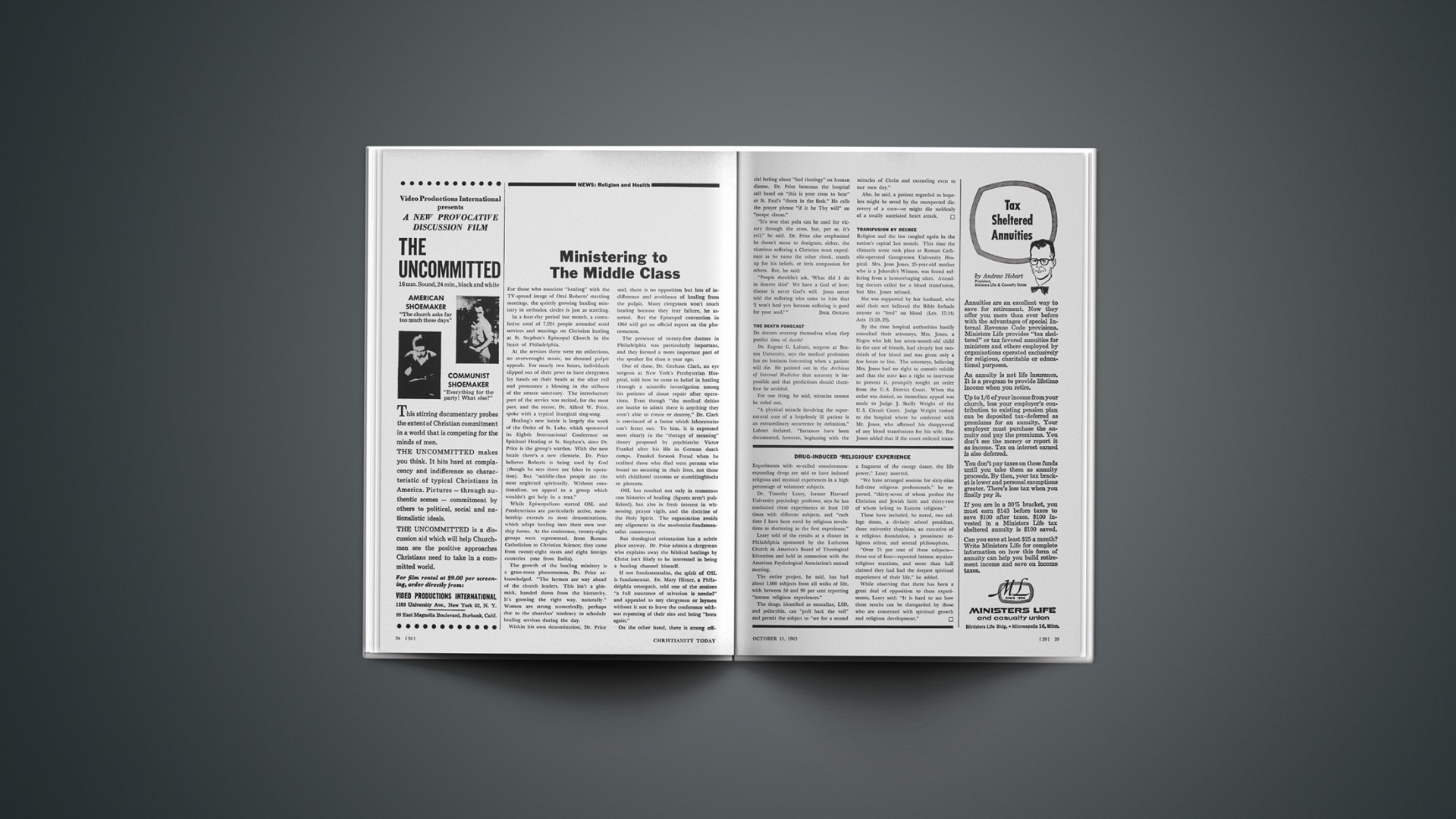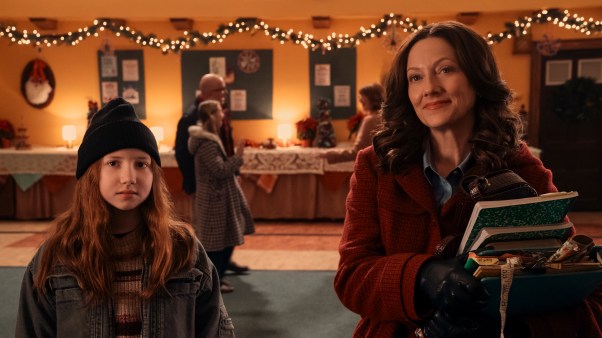For those who associate “healing” with the TV-spread image of Oral Roberts’ startling meetings, the quietly growing healing ministry in orthodox circles is just as startling.
In a four-day period last month, a cumulative total of 7,224 people attended staid services and meetings on Christian healing at St. Stephen’s Episcopal Church in the heart of Philadelphia.
At the services there were no collections, no overwrought music, no shouted pulpit appeals. For nearly two hours, individuals slipped out of their pews to have clergymen lay hands on their heads at the altar rail and pronounce a blessing in the stillness of the ornate sanctuary. The introductory part of the service was recited, for the most part, and the rector, Dr. Alfred W. Price, spoke with a typical liturgical sing-song.
Healing’s new locale is largely the work of the Order of St. Luke, which sponsored its Eighth International Conference on Spiritual Healing at St. Stephen’s, since Dr. Price is the group’s warden. With the new locale there’s a new clientele. Dr. Price believes Roberts is being used by God (though he says there are fakes in operation). But “middle-class people are the most neglected spiritually. Without emotionalism, we appeal to a group which wouldn’t get help in a tent.”
While Episcopalians started OSL and Presbyterians are particularly active, membership extends to most denominations, which adapt healing into their own worship forms. At the conference, twenty-eight groups were represented, from Roman Catholicism to Christian Science; they came from twenty-eight states and eight foreign countries (one from India).
The growth of the healing ministry is a grass-roots phenomenon, Dr. Price acknowledged. “The laymen are way ahead of the church leaders. This isn’t a gimmick, handed down from the hierarchy. It’s growing the right way, naturally.” Women are strong numerically, perhaps due to the churches’ tendency to schedule healing services during the day.
Within his own denomination, Dr. Price said, there is no opposition but lots of indifference and avoidance of healing from the pulpit. Many clergymen won’t touch healing because they fear failure, he asserted. But the Episcopal convention in 1964 will get an official report on the phenomenon.
The presence of twenty-five doctors in Philadelphia was particularly important, and they formed a more important part of the speaker list than a year ago.
One of these, Dr. Graham Clark, an eye surgeon at New York’s Presbyterian Hospital, told how he came to belief in healing through a scientific investigation among his patients of tissue repair after operations. Even though “the medical deities are loathe to admit there is anything they aren’t able to create or destroy,” Dr. Clark is convinced of a factor which laboratories can’t ferret out. To him, it is expressed most clearly in the “therapy of meaning” theory proposed by psychiatrist Victor Frankel after his life in German death camps. Frankel forsook Freud when he realized those who died were persons who found no meaning in their lives, not those with childhood traumas or stumblingblocks to pleasure.
OSL has resulted not only in numerous case histories of healing (figures aren’t publicized), but also in fresh interest in witnessing, prayer vigils, and the doctrine of the Holy Spirit. The organization avoids any alignment in the modernist-fundamentalist controversy.
But theological orientation has a subtle place anyway. Dr. Price admits a clergyman who explains away the biblical healings by Christ isn’t likely to be interested in being a healing channel himself.
If not fundamentalist, the spirit of OSL is fundamental. Dr. Mary Hitner, a Philadelphia osteopath, told one of the sessions “a full assurance of salvation is needed” and appealed to any clergymen or laymen without it not to leave the conference without repenting of their sins and being “born again.”
On the other hand, there is strong official feeling about “bad theology” on human disease. Dr. Price bemoans the hospital call based on “this is your cross to bear” or St. Paul’s “thorn in the flesh.” He calls the prayer phrase “if it be Thy will” an “escape clause.”
“It’s true that pain can be used for victory through the cross, but, per se, it’s evil,” he said. Dr. Price also emphasized he doesn’t mean to denigrate, either, the vicarious suffering a Christian must experience as he turns the other cheek, stands up for his beliefs, or feels compassion for others. But, he said:
“People shouldn’t ask, ‘What did I do to deserve this?’ We have a God of love; disease is never God’s will. Jesus never told the suffering who came to him that ‘I won’t heal you because suffering is good for your soul.’ ”
The Death Forecast
Do doctors overstep themselves when they predict time of death?
Dr. Eugene G. Laforet, surgeon at Boston University, says the medical profession has no business forecasting when a patient will die. He pointed out in the Archives of Internal Medicine that accuracy is impossible and that predictions should therefore be avoided.
For one thing, he said, miracles cannot be ruled out.
“A physical miracle involving the supernatural cure of a hopelessly ill patient is an extraordinary occurrence by definition,” Laforet declared. “Instances have been documented, however, beginning with the miracles of Christ and extending even to our own day.”
Also, he said, a patient regarded as hopeless might be saved by the unexpected discovery of a cure—or might die suddenly of a totally unrelated heart attack.
Drug-Induced ‘Religious’ Experience
Experiments with so-called consciousness-expanding drugs are said to have induced religious and mystical experiences in a high percentage of volunteer subjects.
Dr. Timothy Leary, former Harvard University psychology professor, says he has conducted these experiments at least 150 times with different subjects, and “each time I have been awed by religious revelations as shattering as the first experience.”
Leary told of the results at a dinner in Philadelphia sponsored by the Lutheran Church in America’s Board of Theological Education and held in connection with the American Psychological Association’s annual meeting.
The entire project, he said, has had about 1,000 subjects from all walks of life, with between 50 and 90 per cent reporting “intense religious experiences.”
The drugs, identified as mescaline, LSD, and psilocybin, can “pull back the veil” and permit the subject to “see for a second a fragment of the energy dance, the life power,” Leary asserted.
“We have arranged sessions for sixty-nine full-time religious professionals,” he reported, “thirty-seven of whom profess the Christian and Jewish faith and thirty-two of whom belong to Eastern religions.”
These have included, he noted, two college deans, a divinity school president, three university chaplains, an executive of a religious foundation, a prominent religious editor, and several philosophers.
“Over 75 per cent of these subjects—three out of four—reported intense mystico-religious reactions, and more than half claimed they had had the deepest spiritual experiences of their life,” he added.
While observing that there has been a great deal of opposition to these experiments, Leary said: “It is hard to see how these results can be disregarded by those who are concerned with spiritual growth and religious development.”
Transfusion By Decree
Religion and the law tangled again in the nation’s capital last month. This time the climactic scene took place at Roman Catholic-operated Georgetown University Hospital. Mrs. Jesse Jones, 25-year-old mother who is a Jehovah’s Witness, was found suffering from a hemorrhaging ulcer. Attending doctors called for a blood transfusion, but Mrs. Jones refused.
She was supported by her husband, who said their sect believed the Bible forbade anyone to “feed” on blood (Lev. 17:14; Acts 15:28, 29).
By the time hospital authorities hastily consulted their attorneys, Mrs. Jones, a Negro who left her seven-month-old child in the care of friends, had already lost two-thirds of her blood and was given only a few hours to live. The attorneys, believing Mrs. Jones had no right to commit suicide and that the state has a right to intervene to prevent it, promptly sought an order from the U. S. District Court. When the order was denied, an immediate appeal was made to Judge J. Skelly Wright of the U. S. Circuit Court. Judge Wright rushed to the hospital where he conferred with Mr. Jones, who affirmed his disapproval of any blood transfusions for his wife. But Jones added that if the court ordered transfusions his responsibility would end. Judge Wright then conferred with the several doctors, who unanimously and strongly recommended transfusions, saying that with them Mrs. Jones would have a good chance of survival.
Judge Wright next conferred with the patient, who confirmed her opposition. He then asked whether she would refuse transfusions if the court ordered them. “She indicated, as best I could make out,” reports Judge Wright, “that it would not then be her responsibility.”
The Very Rev. Edward B. Bunn, president of Georgetown University, appeared on the scene and attempted to convince Mr. Jones that the Bible passages in question did not prohibit blood transfusions, but to no avail.
Judge Wright finally decided to sign the order allowing the hospital to transfuse “to save the patient’s life.” Following the transfusions Mrs. Jones’s condition steadily improved until doctors could pronounce her out of danger.
Dallas Wallace, overseer of Washington’s Jehovah’s Witnesses, stated that during World War II his sect—whose members are also conscientious objectors—adopted this principle of refusing to “feed” on blood, directly or indirectly, whether animal or human. He acknowledged that since then this interpretation has given rise to “hundreds” of cases among the sect’s million followers worldwide. Of these cases some resulted in death. A very recent one, in California, involved a nine-year-old vainly pleading with his father, who subsequently died rather than accept the transfusion.
Wallace believes this is the first time a court has issued an order in a case involving adults all of whom objected to the transfusion.
Judge Wright in his written order admitted unawareness of precise legal precedent for his action, but cited “persuasive analogies.” Many years ago the U. S. Supreme Court had said that a wife who religiously believed it her duty to burn herself on the funeral pyre of her husband may be prevented by the courts from so doing.
Introduction of judicial rulings into the arena of religion and medicine involves significant questions. Would a sectarian hospital be obligated to abide by court rulings which violate the hospital’s moral code?
The Washington Evening Star was highly critical. It editorialized: “Each person in a free society should have the right to exercise his convictions as long as they do not harm other people. The action … by Georgetown University Hospital officials and Judge Wright was an infringement of this basic right of individual choice.”










